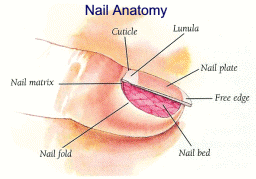Nail Anatomy
 A nail is a horn-like envelope covering the dorsal aspect of fingers and toes in humans. Fingernails and toenails are made of a tough protein called keratin. Along with hair, they are an appendage of the skin. The nail consists of a nail plate, a nail matrix, a nail bed, and the grooves surrounding the nail.
A nail is a horn-like envelope covering the dorsal aspect of fingers and toes in humans. Fingernails and toenails are made of a tough protein called keratin. Along with hair, they are an appendage of the skin. The nail consists of a nail plate, a nail matrix, a nail bed, and the grooves surrounding the nail.
The nail matrix is the tissue upon which the nail rests on and the part of the nail bed that extends beneath the nail root and contains nerves, lymph, and blood vessels. The matrix is responsible for the production of the cells that become the nail plate (body of the nail). The width and thickness of the nail plate is determined by the size, length, and thickness of the matrix. The shape of the fingertip itself determines if the nail plate is flat, arched, or hooked. The matrix will continue to grow as long as it receives nutrition and remains in a healthy condition. As new nail plate cells are incubated, they emerge from the matrix round and white to push older nail plate cells forward; and in this way yet older cells become compressed, flat, and translucent, making the pink color of the capillaries in the nail bed below visible. The lunula, is the visible part of the matrix, the whitish crescent-shaped base of the visible nail.
The nail bed is the skin beneath the nail plate. Like all skin, it is composed of two types of tissues: the deeper dermis, the living tissue fixed to the bone which contains capillaries and glands, and the superficial epidermis, the layer just beneath the nail plate which moves forward with the plate. The epidermis is attached to the dermis by tiny longitudinal “grooves” known as the matrix crests. As we age, the plate grows thinner and these ridges become evident in the plate itself. The nail sinus is the deep furrow into which the nail root is inserted.
The nail plate or body of nail is the actual nail. It is made of translucent keratin protein and amino acids. The plate appears pink because of the underlying capillaries. Its shape is determined by the form of the underlying bone. The hyponychium is located beneath the nail plate at the junction between the free edge and the skin of the fingertip. It forms a seal that protects the nail bed. The eponychium, is the small band of epithelium that extends from the nail wall onto the base of the nail. The layer of non-living, almost invisible skin is the cuticle that “rides out” on the surface of the nail plate. Together, the eponychium and the cuticle form a protective seal. Lastly, the nail wall is the cutaneous fold overlapping the sides and proximal end on the base of the nail.
Function
A nail has the function of protecting the distal phalanx from injuries. It also serves to enhance the sensitivity of the fingertip. Finally, the nail functions as a tool for the extended precision grip”.
Growth
The growing part of the nail is under the skin at the nail’s proximal end. In humans, fingernails grow up to four times faster than toenails. In humans, nails grow at an average rate of 3 mm a month. Fingernails require three to six months to regrow completely, and toenails require 12 to 18 months. Actual growth rate is dependent upon age, sex, season, exercise level, diet, and hereditary factors.
In contrast to the general believing that the nail is an impermeable barrier, it is much more permeable than the skin, and the composition of the nail includes 7-12% of water. This permeability has implications for penetration by harmful and medicinal substances.
Effect of nutrition
A lack of vitamin A, vitamin D, and calcium can cause dryness and brittleness. Not enough B12 vitamin can lead to excessive dryness, darkened nails, and rounded or curved nail ends. Insufficient intake of both vitamin A and B results in fragile nails with horizontal and vertical ridges. Protein is a building material for new nails; therefore, low dietary protein intake may cause white nail beds. A lack of protein combined with deficiencies in folic acid and vitamin C produce hangnails. Essential fatty acids play a large role in healthy skin as well as nails. Splitting and flaking of nails may be due to a lack of linoleic acid. Iron-deficiency anemia can lead to a pale color along with a thin, brittle, ridged texture.
Nail and cold weather in Minnesota
If you live in Minneapolis and St Paul areas, you have more chance to develop the skin and nail problems in the winter time. Your nails are made of the same proteins as skin, which loses moisture during cold weather in Minnesota. Not only that, you’re probably drinking less water, and your hands are more likely to be exposed to wind and cold, and your oil glands aren’t secreting as much as they do in warmer seasons. Then you may over wash your hands more during cold and flu season. Experts recommends rubbing vitamin E oil or shea butter cream into your nails and cuticles once or twice a day , and making sure to drink enough water. Wash your hands with a nonsoap cleanser or a hydrating, and apply a rich cream before slipping on moisturizing gloves you wear to bed.





